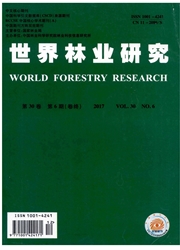

 中文摘要:
中文摘要:
为研究中国林业产业结构演变的趋势和特点,采用灰色预测方法对2012--2030年的林业产值数据进行预测。根据林业3大产业产值在林业总产值中所占的比重将林业产业演变过程分为3个阶段,运用弹性模型分别对这3个阶段的林业产业结构特点进行分析。结果表明,中国林业产业结构由“一、二、三”的结构模式逐渐向“二、一、三”的结构模式演变,到第3阶段演变为“二、三、一”的结构模式;在林业产业结构演变过程中,林业第一、二产业对林业总产值的影响不断增强,并且林业第一产业比第二和第三产业的影响更大,林业第三产业在第2阶段时相对于第l和第3阶段对林业总产值的影响较小。
 英文摘要:
英文摘要:
In order to study the tendency and characteristics of the evolution of China's forestry industrial structure, the gray prediction method was adopted to forecast the forestry production data between 2012 and 2030, and elastic model was used to analyze the characteristics of forestry industrial structure at the three stages of industrial evolution process, which were classified in accordance with the share of the outputs of three major forestry industries in the gross value of forestry production. Results showed that China~ forestry industrial structure has gradually evolved from the structure model of "primary, secondary, tertiary" through the structure model of " secondary, primary, tertiary" at the second stage to the structure model of "secondary, tertiary, primary "mode at the third stage; In the process of forestry industrial structure evolution, the primary and secondary forestry industries have had continuingly increased impacts on the total outputs of forestry industry. Moreover, the primary industry has higher influences than the secondary forestry industry does, while the tertiary forestry industry at the second stage has the least influence on the total outputs of forestry compared to at the first and third state.
 同期刊论文项目
同期刊论文项目
 同项目期刊论文
同项目期刊论文
 期刊信息
期刊信息
